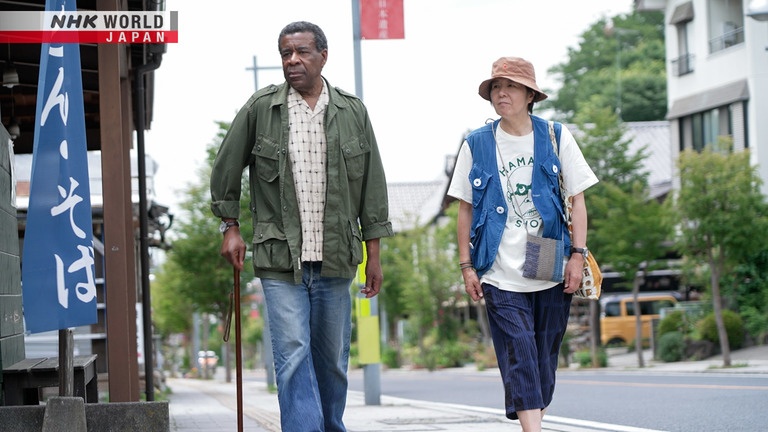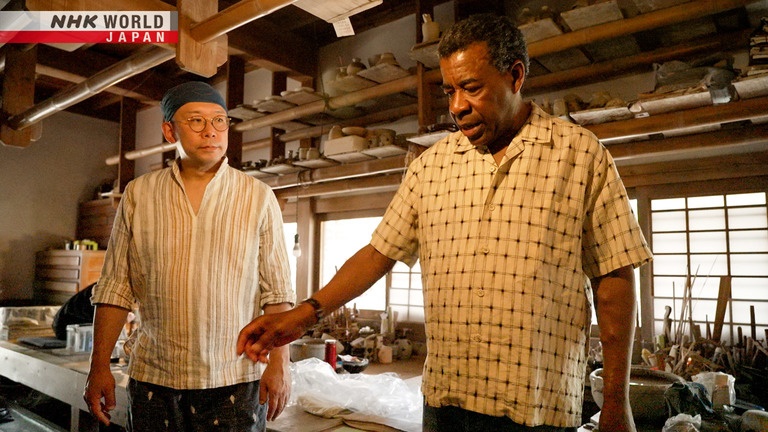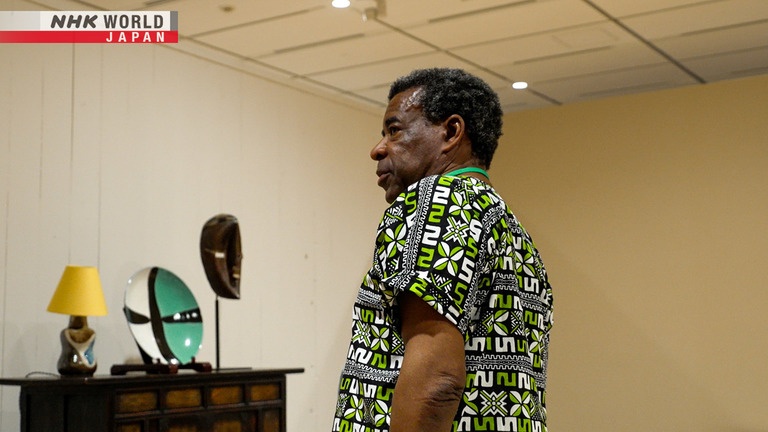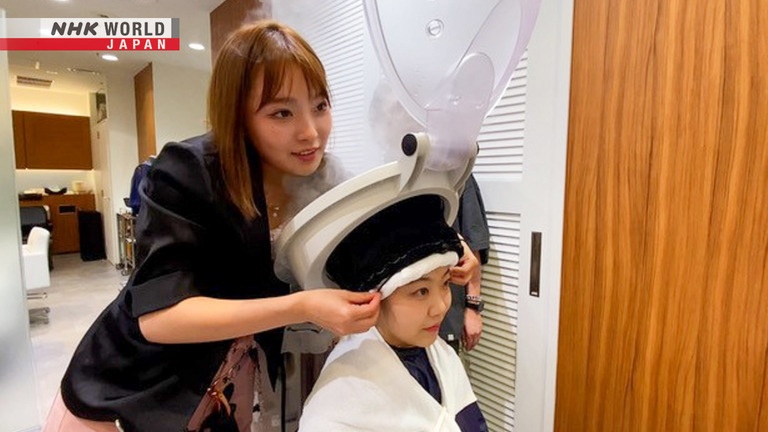Keeping the Fire of Folkcraft Burning
Mass-produced items are nice and cheap, but none have the beauty and warmth of handmade objects. This is especially true in Japan, where handcrafted houseware has long been part of daily living. We follow Terry Ellis from the UK, who from his shop in Koenji, Tokyo, promotes the appeal of folkcraft from all over the country and works to adapt it to modern lifestyles. Later on, still in Tokyo, we drop by a beauty salon in Ikebukuro to meet Chinese Shang Haiyi, who trains to become a hairdresser.




Transcript
Where We Call Home.
Handcrafted housewares for everyday use.
Enamored with these objects made by "nameless craftspeople" is Terry Ellis from the UK.
A bit like modern art.
Each piece is handmade.
His mission is to connect makers and users.
For thirty years, he's visited the places where this folkcraft, or "mingei," is produced.
A lot of mingei is based on a direct appreciation of the object without much information.
Ellis has been pouring his passion into showing how these handcrafting traditions can adapt to the times.
Mingei isn't in decline at all; it's progressing very well, I think.
Beauty in usefulness - let's discover the spirit of folkcraft, and the man who loves it.
About a half-hour train ride from Tokyo's central station is an area named Koenji,
an energetic town where old and new cultures meet and coexist.
It's home to a small shop run by Terry Ellis.
On offer is an eclectic mix of items from African masks to original t-shirts.
From these stout yet warmly simple bowls of Okinawan pottery...
...to these indigo-painted kokeshi dolls from Miyagi Prefecture, the store features folkcraft, or "mingei," from all over Japan.
Welcome.
So, if we're interested in furniture or design or craft, we combine it with clothing.
And, it allows us to not to only focus on clothing, it gives us a wider range of interests.
Dropping by the store is a young couple.
We're moving in together.
We're looking for dishes.
We want something lovely
that's not mass-produced.
...small size, and Okinawa decoration.
Each piece is handmade, and it has...
...fine and shiny, shiny glaze.
Ellis takes the time to explain how and where each piece is made,
wishing to spark the love of these objects that hopefully will become part of their lives for years to come.
In the past, items Japanese used every day were handcrafted by unnamed artisans.
Reflecting the climate and customs of each region, they were part of people's lives.
Such folkcraft was referred to as "mingei."
In 1926, philosopher and art enthusiast Yanagi Soetsu and some craftsmen started the "mingei movement,"
which praised the artistic merits of objects used in daily living, focusing on the "beauty in utility" of those often-overlooked items.
But, during Japan's postwar rapid economic growth,
as more and more people moved from the countryside to cities, lifestyles underwent major changes.
Handcrafted objects were gradually replaced by their more affordable, mass-produced counterparts.
Of course, the lower price is seductive, but you know...
I think it's clearly understood now that handcrafted objects,
especially by, you know, traditional craftsmen, are a good thing.
Though Ellis's shop has only recently opened, it already has regular customers.
Handmade products have
a unique aesthetic appeal.
Ellis feels grateful to have found people who share his appreciation for the handcrafted.
Ellis was born in Jamaica in 1961, back when the country was still a British colony.
When he was seven, his family moved to London.
In the European metropolis, he met Keiko, who, like him worked in the fashion industry, and the two got married.
They were both buyers for a famous chain of Japanese multi-brand stores that sold European fashion.
In the 1990s, Ellis and Keiko were in their thirties when they turned their interest to housewares.
That's when they discovered one item that particularly inspired them -
the "butterfly stool," which was simply comprised of two wooden boards.
A popular product throughout Europe, it was the creation of a Japanese man.
Industrial designer Yanagi Sori - the son of mingei movement founder Yanagi Soetsu.
To Ellis and Keiko who had come all the way from London to visit him, Sori introduced the philosophy at the heart of mingei.
A suggestion from Sori changed Ellis's life.
We should go to Okinawa to look at pottery.
And so, they did.
In 1997, Ellis and Keiko visited Okinawa for the first time,
where they discovered how the region's subtropical climate had influenced the local folkcraft.
And then, I realized that all of those things were reflected in their craft.
That was sort of the turning point in a way of thinking of craft as something very direct from the environment.
The couple was awestruck by the richness of mingei culture.
In 2003, boutiques started carrying the handcrafted housewares they proposed,
promoting their appeal to the trend-sensitive younger generations.
As they neared the age of sixty, Ellis and Keiko set themselves the goal of opening their own shop.
This would give them more freedom to explore the work of artisans nationwide,
as well as current trends to discover new possibilities for folkcraft.
And so, they successfully opened their store in Koenji last autumn.
Well, here we are.
They also develop new concepts for handcrafted pottery that suit modern lifestyles while preserving traditional methods.
Keiko, if could you pass me the Onta.
-This one?
-Yes.
Produced in Oita Prefecture for more than three hundred years - Onta ware.
They proposed adapting this large pitcher into smaller versions.
We've put a stick handle, which looks a little more sort of earlier,
early in the evolution of handle vessels and gives it a sort of... another sort of charm.
So, I imagine it possibly for use as a wine jug or coffee pot.
They kept the Onta's characteristic palette of colors and geometric patterns.
Yeah, I mean, if your work is so high-pressure that you literally have only time to dunk some milk out of a carton from the fridge,
then on your day off or on occasion when you can do this, then it's even more precious, I think.
Over years of use, a handcrafted object gains in charm and beauty as its owner grows fonder of it.
Ellis believes this enriches everyday life.
Ellis is now busy preparing for an upcoming folkcraft exhibition in Osaka this summer.
He was invited to participate by introducing contemporary mingei.
For this, he and Keiko make a two-and-a-half-hour drive from Tokyo to the town of Mashiko in Tochigi Prefecture.
This is where Mashiko ware is produced - a handcrafting technique dating back to the Edo era.
It's notable for its large water jugs, among other everyday items.
It's simple pottery characterized by a gentle and pleasant thickness with glazes of reddish-brown and amber hues.
The couple arrives at their destination - the workshop of Hamada-gama Pottery.
It was set up by one of the founders of the mingei movement, ceramic artist Hamada Shoji, when he moved to Mashiko in 1931.
The workshop is currently run by third-generation owner Hamada Tomo-o, who's been a friend of Ellis for ten years now.
Ellis asked Hamada, inheritor of the traditional Mashiko ware method, to create a new kind of cup.
We made a lot of Japanese pieces...
but now, we make more western-style ones.
The traditional and handle-less "yunomi"
is gradually losing popularity...
to western-style mugs with handles.
It's very rare that we sell yunomi, and we normally, quite often, we sell them to people who are visiting Japan.
Coffee mugs replace the traditional yunomi.
To adapt to changing lifestyles - this is the philosophy of mingei.
Ellis assigned to Hamada the development of something special.
Cups that will be used at a bar near the venue for the Osaka mingei exhibition.
For reference, Ellis sent images of cups...
like these, to which I added a base.
He also suggested adding a handle.
So, I designed this simple handle...
with a stylized leaf shape.
I wouldn't think of ideas
like this without Ellis.
Much better than our first idea.
He's eager to see the finished cups.
Design that doesn't adjust its course to the ever-changing tides of lifestyles and preferences is bound to lose its way, and the interest of users.
For Hamada, Ellis is like a compass.
If I just work in my studio,
I miss out on many ideas and trends.
Ellis understands and shows me
what kinds of products...
better suit current trends and needs.
Whenever Ellis comes to Mashiko, he visits this seventy-year-old shop specializing in mingei.
It's been a while.
So hot today, right?
Here too, Ellis contributed some ideas.
Flower vases transformed into lamps.
Here's one example.
The handle of this flower vase
was taken off...
and a hole was put at the bottom
to make it into a lamp.
Back then, Ellis suggested creating an opening in the side to let the cord through,
but he chose to go with the artisan's idea to put it at the bottom.
It's much easier to make it like this.
Ellis respects and trusts
the artisan's expertise.
We know that, you know, the experience of putting up pots is important for potters.
So, they continue to make these vessels.
The flower vases found themselves a new vocation while retaining their handcrafted charm.
At the Nakanoshima Museum of Art in Osaka, preparations for the mingei exhibition are underway.
Recreated at the venue is a "living space" conceptualized and exhibited back in 1941 by mingei movement founder Yanagi Soetsu.
Everyday items one would gladly use even today -
an assortment of objects put together by Yanagi that embodies his principle of "beauty in utility."
Now, eighty years later, the museum asked Ellis to prepare a contemporary living space imbued with Yanagi's philosophy.
Ellis is someone who promotes "mingei"
products to contemporary consumers.
We felt people could
connect with his ideas.
Here's a plate with triple-colored glaze - the work of Nakai, a crafter in Tottori Prefecture.
Partitioning the room is an "oshirogasuri" tapestry,
handwoven in the Kyushu region with a traditional ikat method that has sadly disappeared.
Is what we're doing good enough for this space, this location, this museum?
And, I still don't know the answer.
I mean, time will tell.
But it's the best we can do.
I respect your, how you look at objects and things, and how you think!
Thank you very much.
I'd say the same about you.
It's like working with, like, you know, Wonder Woman, or someone like that.
While Ellis was setting up the exhibit, Hamada's Mashiko ware pieces arrived at the nearby bar.
Shades of brown from black to reddish adorn the stout and rotund shapes of these ceramic cocktail cups.
Mashiko ware has found itself a fresh new look.
The exhibit is now open.
Simple yet exquisite, each piece expresses beauty in utility - the essence of mingei.
Rather than luxurious and elegant beauty,
I like the kind of beauty...
that comes from the warmth
of everyday objects we can hold.
So, it's very interesting to see the universality of it all.
I wanted to buy everything!
I enjoy... I enjoy wandering around in Koenji.
Ellis strongly wishes to further expand the horizons of folkcraft.
He regularly visits fellow mingei dealers to offer advice.
He's like a mentor.
It's thanks to his advice
that I got here.
Determined to keep the fire of folkcraft burning,
and always in search of new possibilities for mingei to evolve with the changing times, Ellis continues his journey.
We're still traveling to the makers, having conversations, collaborating where we can on site with the materials in hand, and so on.
Because, you know, we can back it up with, you know, our feeling that this is a worthwhile thing
and it's something that, you know, that we understand the motivation of the maker.
Welcome!
I'm Shang Haiyi. I work at a Tokyo
hair salon where we create beauty.
Let me show you my work.
Ikebukuro, Tokyo.
8:45 a.m.
arriving at work.
Good morning!
Shang is in her 3rd month at the salon,
learning Japanese-style hairdressing.
10:30 a.m.
Let me put this
in your collar.
She talks to the customer
to make sure she's comfortable.
I'll apply shampoo.
I have to let air in to make suds.
It was hard at first, but with practice,
I got used to it.
Suds reduce friction and thus
prevent hair damage.
- It's not too strong?
- No.
Thank you.
Let's rinse.
As I rinse, I'm careful not to let
water get into her collar.
- Are you cold?
- No, I'm fine.
- How do you say it in Chinese?
- "Hua ban."
- It means 'snowboard?'
- Yes.
- I asked if she was out.
- When she wasn't here.
You remembered me!
She was so caring.
And she's got a friendly smile.
Thank you!
When she was 15, Shang
and her parents moved to Japan.
Her mother became a certified hairdresser,
but couldn't work in Japan due to her visa.
Shang's mother perfected
her hairdressing skills in Beijing.
After high-school, Shang entered
a beauty college in Japan.
In 2022, a program was launched to train
foreigners in Japanese beauty services.
Shang joined the program, which lets her
train as a hairdresser for 5 years.
Usually, I train under my seniors.
They teach me so much.
We discuss how to better communicate
with customers to improve the service.
When a customer whose hair I washed
or dyed remembers me...
it makes me so happy.
This is Sato-san, our manager.
He's very strict at work, but outside
of working hours, he's very kind.
He's like a friend.
Shang is always cheerful and smiling.
She livens up the atmosphere.
All of the staff noticed
how she's grown in 2 months.
For example, at first, she'd just
drop the towel carelessly.
But now she folds it neatly.
Customers like her.
In 5 years, I hope she becomes able
to do haircuts, coloring and perms alone...
and to attend to all the needs
of a customer by herself.
8:00 p.m.
closing time.
Shang is taking
a hair treatment skill test.
She's being evaluated
on 8 criteria.
If she passes, she'll be able
to do hair treatments.
You have 10 minutes.
And... start!
I'm going to do a mist treatment.
Now, I apply a cream.
This is to seal in
all the treatments we've done.
Time's up!
And the result?
I'm afraid you didn't pass this time.
A customer's hair is important.
You have to put it down gently.
The customer can see it in the mirror.
Shang failed because
of some minute detail.
If you don't keep that in mind,
you can't do hair treatments yet.
Please be mindful of that.
- Alright? That's all.
- Thank you.
I was too nervous.
I want to improve quickly.
My parents gave me this comb I treasure.
Since my parents became hairdressers
20 years ago, they've kept in touch...
with customers like friends.
I want to be like my parents.
I can't wait to do haircuts.
5 years from now, I want to continue
to work here at this hair salon.